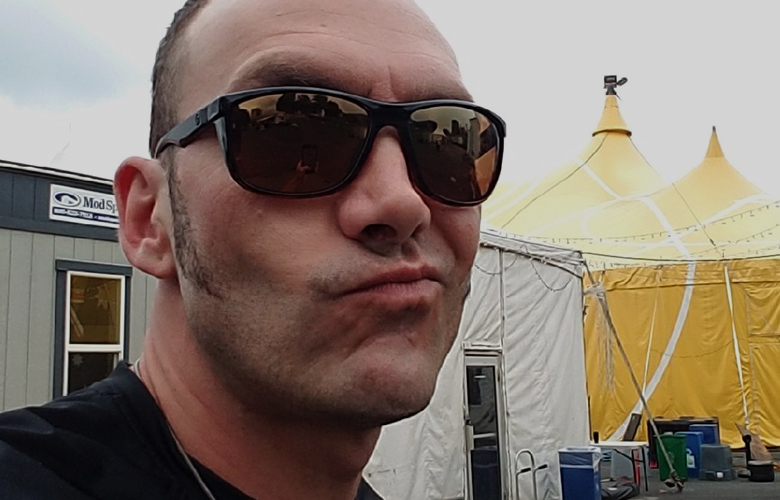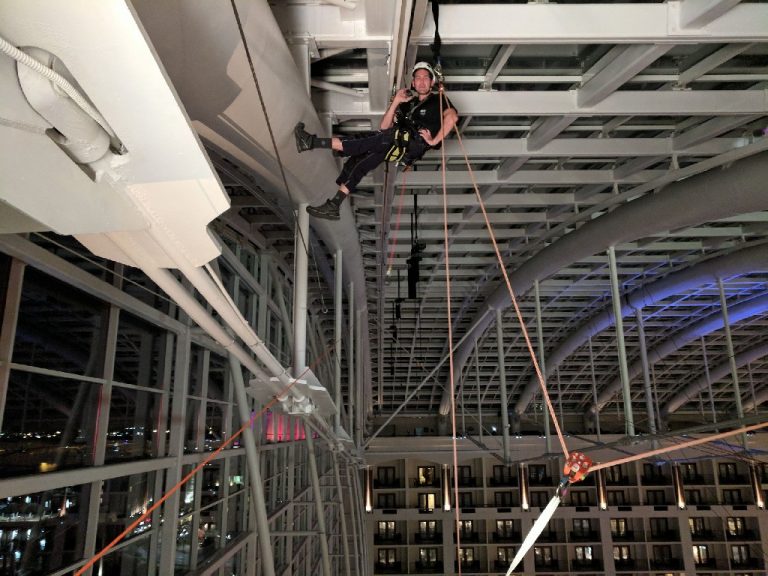
TheatreArtLife has connected with a number of Entertainment Riggers across the globe to bring you their stories, experience and advice on the very crucial roles and responsibilities Riggers hold in today’s industry. James Busby from Washington DC begins our series. Here is his story:
Like many others in the industry, I happened upon it by chance. After stumbling into a theater in Detroit, I had a conversation with the owner that was building a call list for an outdoor roof build. It was Metallica’s Summer Sanitarium Tour, 2004. I agreed to work it, found that I loved it. 2 weeks later, I was chasing roof builds across the country.
It wasn’t until 2 years later when I had my first opportunity to rig in an Arena. My experience building roofs had prepared me to enter the building, learn how to build wire rope anchor configurations, and head up to pull my first point. A 1ton deadhang with 80′ of chain. That’s about 85lbs in a 100′ arena grid. I loved it, I was good at it, and I was determined to be the best at it.
Certification for Riggers is still a very contentious qualification. Although there currently is a program in place, ESTA’s ETCP for Arenas and theaters, many Riggers contend that the certification is inadequate for accurately evaluating the skill level of a particular Rigger.
There are certifications for associated mechanics Riggers use which includes chain hoist schools and rope access certifications. These increase a Rigger’s versatility but aren’t necessary for a majority of the duties required by a Rigger. Now understand, the actual responsibilities for a Rigger vary greatly, depending on the type of rigging required by the job or venue. Even in each job and venue, there are a variety of skill levels required.

Each one of these skill levels, in each and every possible situation that may be encountered means that a “Good” Rigger must be knowledgeable in a very wide range of duties and responsibilities.
Bottom line, a “good” Rigger will have demonstrated knowledge both on a paper exam and certification, practical application of rigging techniques in a variety of situations, and have many years of experience where the opportunities for creative problem solving can present themselves.
After being a Rigger for any length of time, you quickly realize that what makes a production fun or interesting has nothing to do with who the talent is. My favorite gigs are those that require interesting and unusual rigging techniques. Stunt and flying effect rigging is the most fun work I do.
Designing rigging techniques and hardware, supervising performer and aerialist uses of these systems, and witnessing spectator awe when everything is done correctly is the pinnacle of joy in my professional rigging career.
I believe a balance of humility and confidence is absolutely requisite to a professional Rigger. On one hand, you MUST have faith in your skills, and the material you work with, in order to effectively apply and utilize rigging. But you must also be open to accepting the limitations of your skills and know when to consult a Rigger who is better than you are. (And there is ALWAYS a Rigger who is better than you out there).
Acceptance of these qualities in a Rigger keeps him/her safe and effective in Entertainment Production Rigging. Safety IS the #1 responsibility taken on by a Rigger. Nothing else matters if dangerous situations are present. Rigging is one of the most dangerous departments on a production so we are tasked with safety as our priority.

No one should start as a Rigger. A Rigger must have an understanding of how all departments work, and what challenges might be created by these departments, to rigging. I believe an appropriate career path into rigging would include some basic experience in every department BEFORE even thinking about rigging.
After these experiences, then a slow, supervised transition into the rigging department could be considered. In some small way, Riggers aren’t made, they are born. It takes a mechanical aptitude, a level of personal responsibility, and an attention to safety and detail. These skills are not typical for many people, and isn’t guaranteed even among those who practice it. The same honesty in yourself in assessing whether or not you have what it takes is the same level of honesty required to perform this job responsibly.
This is the easiest question of all. There is NO typical day. The closest approximation is the Standard Operating Procedure to get any particular job done. But the variables regarding tour crew, the materials, the site conditions, and even the interpersonal interactions ensure a different experience every day.
I have developed relationships with a number of different Riggers who specialize in different areas of rigging. I consult with these Riggers any time I have a question or doubt. These relationships are crucial in my ability to tackle unfamiliar challenges and reduce risk.
I’m an avid adventurer and thrill-seeker, seldom shying away from opportunities to experience new things, as is my nature. Being an Entertainment Rigger has informed and shaped my approach and perspective to life and everything that happens in it.
I am so very thankful to the industry, and the men and women who compose it. They accept me as a family member, and continually challenge me to be the best I can be.
While in the industry, I went back to college to finish my education in Architectural design; a life-long passion of mine. I continue to find ways to apply my design skills and my knowledge of structures and building systems. This improves my effectiveness as a Production Rigger. One of these days, I will retire from the Entertainment Industry and commit myself to contributing to our built environment.

Dani Bellar Pilukas: Principal Show Programmer For Walt Disney Imagineering
Touring With Cirque Du Soleil: Tanya Burka


Anna Robb is Co-Founder and Managing Director for TheatreArtLife. Anna is an experienced Producer/Production Stage Manager. Her 20-year work history spans Asia Pacific, the Americas, Africa, the Middle East and Europe. She has worked for companies such as Cirque du Soleil, Franco Dragone Entertainment Group, Christie Digital Systems and The Sydney Opera House. Anna was an integral part of the research and development, training and formation, creation and operation of the 250 million dollar aquatic show, The House of Dancing Water in Macau. She also maintained the daily operations of this complex show as the head of Stage Management for 7 years. Anna has been employed on over 70 shows in the areas of concerts, arena events, corporate events, trade shows, musical theatre, plays, dance, circus, outdoor festivals and mega shows. Anna holds a honours degree in Design for Theatre and Television and is passionate about the evolution of the industry.
Read Full Profile© 2021 TheatreArtLife. All rights reserved.

Thank you so much for reading, but you have now reached your free article limit for this month.
Our contributors are currently writing more articles for you to enjoy.
To keep reading, all you have to do is become a subscriber and then you can read unlimited articles anytime.
Your investment will help us continue to ignite connections across the globe in live entertainment and build this community for industry professionals.